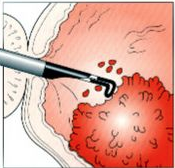 Scientific Editor: Editorial Board ISUD website
Scientific Editor: Editorial Board ISUD website
What isTURBT?
TURBT (Transurethral Resection of Bladder Tumor) is a transurethral surgical procedure indicated for removing part of tissue from the bladder, usually in the case of noninvasive papillary carcinoma.
When is TURBT performed?
TURBT is conducted for the diagnosis and therapeutic treatment of superficial bladder tumors.
What preparation is required?
Standardized hospital preoperative preparation includes blood tests, chest X-ray and ECG (electrocardiogram).
In case you are on anticoagulant therapy, you should always inform your doctor. You will be given instructions to interrupt them for some days before the procedure and, if necessary, replace them with low molecular weight heparin injections.
How is the procedure performed?
The procedure requires general or spinal anaesthesia, with patient placed in the gynaecological examination position. Initially, the genital area is cleansed and the urethra lubricated. A special camera is inserted through the urethra searching for abnormal areas of the bladder to be removed with the use of an instrument attached to the camera. This instrument uses heat to remove abnormal tissue. Then the site is cauterized to prevent bleeding. If there is suspicion for malignancy, the surgeon obtains tissue sample for biopsy. At the end of the procedure, a catheter is placed for continuous bladder irrigation with normal saline.
The average length of hospital stay is about 3 days, depending on the size of bladder tumor. The catheter is usually removed on the first postoperative day.
What about after TURBT?
In case there is blood in urine (haematuria) during the first postoperative days, catheter removal is delayed and continuous bladder irrigation is maintained for longer.
Upon discharge from hospital, you will be given specific written instructions about:
- what antibiotic regimen you have to take
- when you will obtain the histological tissue examination results
- what sort of follow-up is required
- how long you should abstain from physical exercise
- how important it is to drink plenty of fluids
You should consult your physician about when to restart your anticoagulant therapy.
Depending on the size of tumor or histological result, the procedure may have to be repeated within 2 or 6 weeks.
How does TURBT affect patient’s life?
Most patients face no problem after the procedure. In case the patient has been diagnosed with superficial cancer, there is follow-up with cystoscopies on a regular basis. In some cases, patients may be benefited from a chemotherapy drug that is infused into the bladder through a catheter. Such a decision will be determined by the histological tissue examination results.
Should the histological examination reveal some invasive bladder cancer, your physician will inform you about the therapeutic options that are indicated for you.
With regard to your postoperative nutrition, you should be receiving about 1500ml fluids/day and avoid consuming coffee and alcohol that may potentially cause irritative symptoms.
Should the histological examination reveal some papillary bladder tumor, it is absolutely imperative to give up smoking, for there is evidence showing that giving up smoking significantly reduces the relapse risk of the disease.


